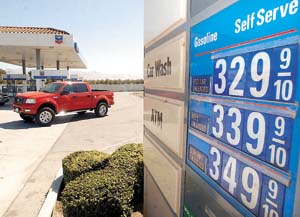Blame it on Hurricane Katrina, the war in Iraq, your neighbor’s
gaudy SUV or whatever you like: consumers are paying record prices
for gas, and conditions don’t look to improve any time in the near
future.
Hollister – Blame it on Hurricane Katrina, the war in Iraq, your neighbor’s gaudy SUV or whatever you like: consumers are paying record prices for gas, and conditions don’t look to improve any time in the near future.
Gas prices have jumped to the $3 mark in San Benito County, and locals are trying to take it in stride – even if they’re not particularly happy about it.
“I’m mad about it, just like anyone,” said resident Wendy Philpott, filling up the tank on her minivan Safeway’s gas station. “But so far my (spending) habits haven’t really changed. They should have, though.”
Despite the rapid increase in price, the AAA of Northern California isn’t anticipating empty freeways this weekend, as Labor Day is the last vacation many working folk will see until November. Approximately 3.8 million people will be taking to the road this weekend, according to AAA’s most recent surveys.
“By the time people get to take time off work, they feel they’ve earned that vacation,” said Sean Comey, spokesperson for AAA’s Northern California branch. “Somehow the tank of gas you buy to go on vacation hurts less than the one to commute to work … actually, our research suggests a slight increase in travel as opposed to this time last year, but that was done prior to the hurricane.”
They may not be willing to sacrifice their annual camping trip or beach bonfire, but Americans are increasingly worried about rising gas prices. About 1/4 of adults under 65 named gas prices as a top domestic priority, according to an Associated Press poll released yesterday.
In order to increase the available gas and diesel supply, President Bush has released oil from the government’s emergency stockpile and temporarily let up on pollution standards. He also urged Americans to conserve.
“Steps we’re taking will help address the problem of availability but it’s not going to solve it,” Bush said yesterday. “Don’t buy gas if you don’t need it.”
In San Benito County, at least, prices may dissuade consumers from buying what they don’t believe they absolutely need. Local gas stations are charging between $2.97 and $3.09 per gallon, for an average of $3.01.
“I don’t go anywhere I don’t absolutely have to go,” said resident Roger Brown as he finished fueling his car at Safeway’s gas station. “It’s gotten too expensive. And I’m just going to go fishing this weekend. It’s a cheap trip.”
While consumers may feel that $3 is outrageous, Americans have paid less to fuel their car than most other countries, in the past. Citizens of Amsterdam, Netherlands pay $6.48 per gallon as of March, according to CNN Money. That doesn’t mean, however, that consumers have to lie down and wait for prices to get that high.
“Shop aggressively for the best value,” said Comey. “Not only will you be saving money, but another benefit is that your purchase power sends an economic message to those setting the gas prices … and don’t buy premium gas unless your owner’s manual specifies that it’s necessary. Twenty to 30 percent of all gas bought is mid-range or premium fuel. People throw away money every year buying gas that isn’t doing your car any good. It’s beyond me why anyone would buy fuel like that.”
Comey also stressed the importance of regular car maintenance. Keeping the tires inflated and filters clean alone can save consumers over 10 percent a year gas costs.
Commuters, of course, stand to be hit by rising prices especially hard. With so many Hollister residents commuting to San Jose every day, an increased demand for alternate modes of transportation may arise.
“People think of conservation in drastic terms,” said Comey. “You don’t necessarily have to trade in your SUV for a Prius. But if everyone carpooled just once or twice a week to work, even that would make a huge difference.”
Americans today drive 2.5 trillion miles a year, double what they did in 1980 when gas prices set a record at $2.59 a gallon, according to the US. Department of Economics.
“In the short run, I think prices will get worse, to be honest,” said Comey. “But in the long run, there’s a lot of potential for it to get better. As recently as earlier this year we were all paying less than $2 a gallon, it’s important to remember that.”










